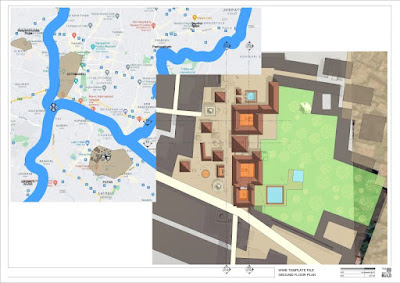Somewhere roughly over Mogadishu. On my way back to Zimbabwe for what could perhaps be the last time. I hope not, but given how long it's been and all the different kinds of water that have flowed under myriad bridges... You never know.
I lost my citizenship during the pandemic. I had always intended to go back to
Harare to retire. My hand was forced, but then I realised it no longer made any
sense. That troubled country still clutches at my heart. It will be an
emotional trip, I'm selling my house. Shipping a few things and letting go of
the rest.
Almost 20 years now since I moved to Dubai. Economic necessity with university
fees looming. I was working as hard as ever, but most of the projects never got
off the ground. It was fun in a way, doing concept after concept. I think I
imagined that we would bounce back in a year or two. Exploring an integrated 2D
/3D approach but I didn't really have the tools yet.
I watched a podcast recently with the guy who started @last software. They knew that people were using it for free, but he didn't care. He reasoned that if the community grew big enough and people loved the experience, profitability would come in time. Interesting guy.
I was hoping to get my hands on Architectural Desktop but nobody had a broken version. Those were interesting times. Queueing all day for petrol. Buying groceries in bulk because they held their value better than paper money. Then suddenly I was on a plane to Dubai, little realising I would stay for twenty years.
But now the sands are starting to shift beneath my feet again.
These
two buildings in Zimbabwe have something in common. They were designed by the
same person. Apart from that, they are worlds apart, symbols perhaps of the
enormous gap between rich and poor.
One is in the capital, also a city of contrasts, with its leafy northern
suburbs, and dusty townships. The other is deep in the rural areas, where land
tenure operates along traditional lines. I offer no judgement. Are modern ways
better? By some standards yes. By others perhaps not.
Either way, resistance is futile. You can retreat into the simple physicality
of a life on the land, but sooner or later the tentacles of modernity will seek
you out.
I designed both these buildings and this week I saw them again after almost two
decades. Time spent in that desert fantasy called Dubai, also a city of
contrasts. Like so many Zimbabweans I went overseas in search of money, for the
betterment of my family.
There have been ups and downs, but ultimately no regrets. And likewise, I
remain proud of these two buildings, equally so, in fact. Though for different
reasons.
It's great to be back.
Sam Levy's Village where life seems good. Could all of Zimbabwe have seen prosperity like this by now, almost 45 years after independence?
By way of contrast, here is Chivu, where we turned left, on our journey down "kumusha." Life goes on, in its own dusty way. There is a deeper history here. The post office echoes the government style of the 1930s. A small and simple building, but given dignity by just a hint of the classical spirit.
The hotel no longer operates, I think. Not a beautiful building perhaps, but redolent of the Dutch colonial style that once held sway in Southern Africa.
Finally, the retail traders of Indian origin who were willing in the 50s and 60s to invest in shops that served the needs of the majority population. A pragmatic approach to building but it has a character all the same, a recognisable ambience. It speaks the truth about itself.
"The Way We Build" is a never ending story of human life, of materials, climate and culture.
While
at Rusununguko I started working on a children's alphabet book. As a project,
it didn't go very far, but this was one of the early studies.
I was relatively fresh from the UK and a period of my life when I flirted with
the idea of becoming an illustrator and visual story teller. I was fascinated
by the challenge of using my freehand Rotring pen drawing style to depict the
very different landscape and culture I found myself in.
On reflection, I decided that a simpler style would be good for young children
learning to read, so I came up with this character called "hari"
(sounding like a Christian name in English and the Shona word for a clay pot)
I thought all this work was lost. I didn't even remember very clearly what I
had done, but while sorting through the remnants my papers in Zimbabwe, I came
across these drawings.
A mixture of emotions. The excitement of discovery. Pride in the creativity of
my younger self. Disappointment at how many projects I have started but never
finished.




















